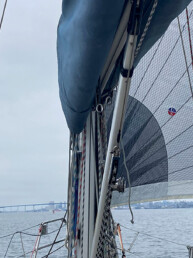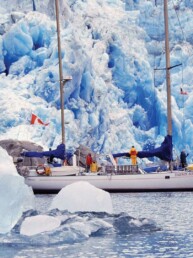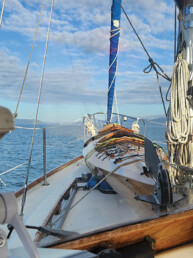Congratulations, you’re making the leap or are seriously scheming how to do so. After many happy long weekends and blissful week-long cruises in local waters, you’ve successfully secured a month or a summer or maybe even longer to get out for an extended cruise. Now, the real work begins to get your boat ready to cast off the dock lines for new adventures ahead.
No matter what your timeline or destination may be, it’s exciting to begin preparing for the voyage of a lifetime; but it takes a lot to get to this proverbial starting point. Planning a route and readying a vessel for cruising can be overwhelming, and the uncertainty of what will come when you leave the friendly confines of your home marina can be uncomfortable. While you, your boat, and your dreams are unique, luckily others have crossed these potentially rough waters and can offer insight.
When preparing our Grand Soleil 39, Yahtzee, to depart Seattle for extended cruising, the lists were so long and the projects so intimidating we wondered if we’d ever leave. Indeed, the process was daunting, but we learned so much before we even started sailing north to Alaska. Most importantly, I can confidently say that all the effort was worth the reward. Hopefully some of what we learned then and over the last decade of cruising can be helpful to you in your journey.

Know Your Boat
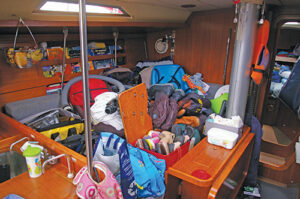
The best way to know what your boat needs is to use it. One of the biggest factors that helped our immediate cruising success was that we accumulated a lot of local experience on Yahtzee first. We sailed and raced after work, and used any time off of work to enjoy the waters of the Pacific Northwest. Of course, we also set aside time to work on the boat, but we carefully prioritized projects and tried not to let them get in the way of actually using our boat.
Lucky for us, the Salish Sea has an embarrassment of cruising riches. From nearly any harbor in the PNW, you are mere miles from the next anchorage, marine park, or port. It can be both fun and valuable to explore locally and get used to living on your boat with your crew where passages can be short and resources near at hand. Once you leave on your trip, that’s exactly what you’ll be doing but you’ll almost certainly have to be more self-sufficient. Overnights and weekend trips help you get to know your boat’s systems away from the dock. How well does your anchoring setup work? Do your batteries hold a solid charge when you’re not on shore power? Do you have solar panels installed and, if so, are they keeping up with what you’re using? How comfortable are you getting in and out of your dinghy with a bunch of gear or provisions?

full-time cruising.
Slightly longer trips reveal other important questions. How often will you need to fill water and fuel, or pump your holding tank? Where are the undiscovered storage spaces for additional food? How frequently do you feel like you need time ashore?
It’s also important to sail your boat in a variety of conditions. Practice skills like reefing and heaving-to so you know what to do before heavy weather arises. And, if you have one, become proficient at flying your spinnaker when the winds inevitably go light; it’s a fun and rewarding skill to master. Rig jacklines in calm conditions and clip in with a tether and harness to get used to moving up and down the deck while the boat is underway. You’ll thank yourself later when you have to do it at night or in the midst of a nasty blow.
When you’re bound to the dock, get to know every nook and cranny of your boat—even if you’ve owned the boat or have lived aboard for years. Storage of food, water, spare parts, tools, and even garbage is going to be key when you’re cruising, so clean out lockers on deck and down below, and then reorganize them to figure out what will maximize efficiency for the way you will use the boat. This can be hard, but while things are out, purge any items that you really don’t need. The simple act of moving on from unnecessary clutter can be extremely freeing and you’ll create more space in the process.
One point of caution in getting your boat ready, though, is to resist the urge to make everything “perfect” before you leave. Perfection is not realistic, and can lead to stress or more time spent at the dock instead of… you know… actually being out cruising.
Be Handy

Get ready to fix stuff. Lots of stuff. Rightfully so, every experienced cruiser will harp on the need for spare parts, so I won’t go into great detail about what you actually need. What’s important to remember, is that those spare parts are useless if you don’t know how to use them to fix what is broken.
When we first started cruising full-time in the Pacific Northwest, we thought we had our heating system figured out. In truth, we’d really only tested it a few times while off the dock. Once winter came and we were no longer on shore power and able to use space heaters, I was forced to evolve into a capable heater repairman to keep the temperature appropriate for a family with a baby and toddler. By becoming proficient at this, we were able to keep the boat dry and comfortable, which led to a happy crew and better cruising. Still, I had to learn it on the fly when we were in serious need of a functioning system.
That’s just one example and, over 10 years later after countless cruising refinements, I’m still fixing things on a near daily basis—everything from splicing lines to simple electrical jobs like wiring cabin fans to solving plumbing problems with an annoying mish mash of parts from various countries. This all comes back to knowing your boat. The more you’ve worked on it before leaving, the more you’ll be able to do while you’re out.
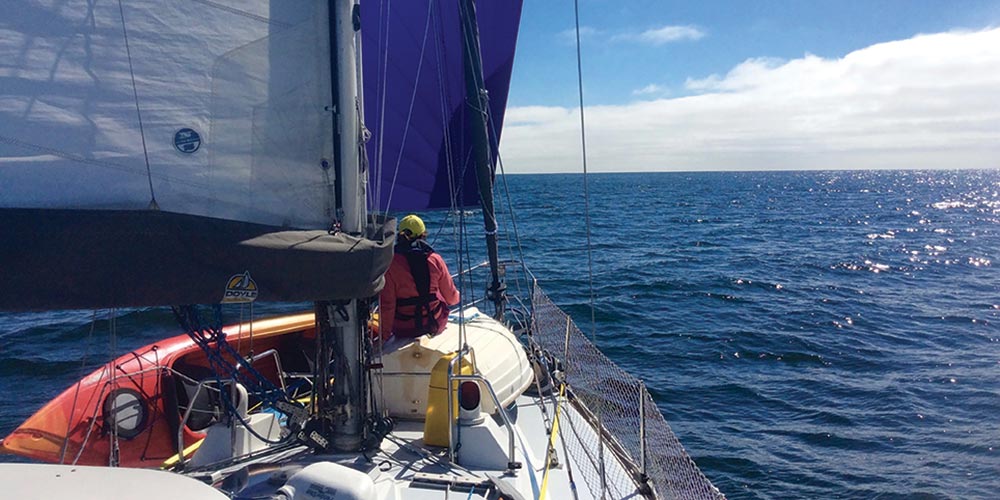
your spinnaker is essential in the light airs of summer in the PNW.
Have a Reliable Engine
Yes, notable cruisers have sailed many thousands of miles without an engine and that is a fine way to go if it’s what you choose. But the bottom line is that you’re not getting far if you don’t have wind, and if you encounter adverse currents like we have throughout the entire length of the Inside Passage, forget about it. Moreover, engineless cruising is not what most of us choose, and being incidentally engineless can be anything from an annoyance to an emergency. You need an engine and enough fuel to push you through calms and fight headwinds and contrary currents. We always hoped to sail as much as possible, and we found that lots of miles can be made under sail; but it’s a fact of cruising life that if you don’t play it right with weather and tides, you’re not getting very far very fast, or you could find yourself in some exceptionally dangerous situations.
Unfortunately, we’ve learned firsthand about the frustrations of not having a working engine at various times in our cruising adventures. When it doesn’t work, the stress can be overwhelming. Before shoving off, have a competent mechanic go through your engine’s systems with you and consider getting an oil sample tested. Clean your fuel tanks and make sure you have a way to easily inspect them. And then stay on top of the engine’s maintenance schedule as you put more hours on it.
Another thing to note here is that mechanics, parts, and services for your engine usually get fewer and farther between as you go. It’s a good idea, then, to be comfortable with most of the general maintenance that your engine may need. Be self reliant—carry spare filters, fluids, and parts, and know how to change many of them in the event of a failure.
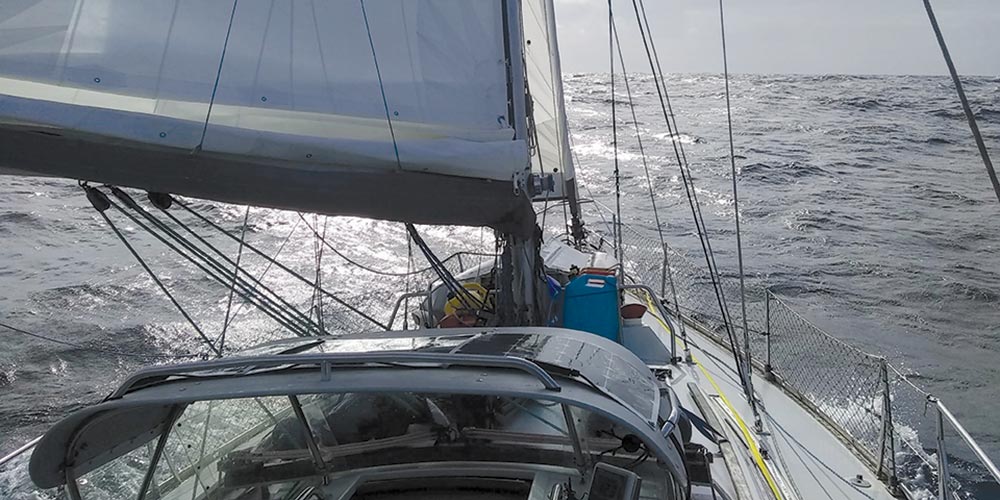
Sailing offshore with a reef in the mainsail and a partially furled genoa.
Plan for Provisions
Self sufficiency is also the name of the game when it comes to provisioning for the amount of crew you have aboard. Sure, you can find food anywhere you find people, but bear in mind that expense and availability of certain items changes in more remote locales. Getting fresh fruits and vegetables can be somewhat challenging in rural areas of British Columbia and Alaska, yet there’s not much you can do about it. Stores will either have it or they won’t, and the farther from peak season you arrive, the less likely it will be that stores are fully stocked. Because of this, we’ve made sure to have an adequate amount of canned fruits and veggies to accommodate the times when stores were lacking. Additionally, for items that we know our crew loves—like certain types of snacks and drinks—we buy extra before leaving.
Fresh water is another important consideration. How much water does your boat carry and how much does your crew use per day or week? Ideally, you want to refill before you run out, so what’s the plan for where you get that water? Reliable watermakers are becoming more common onboard many cruising boats, but you need to know what conditions they can be run in. Most watermakers like to have clean ocean water running through them to make the best fresh water. If you’re in silty areas, or places where there is more algae in the water, your watermaker might not be able to keep up or you may risk damaging the unit’s membrane. Consider whether or not your boat or journey requires carrying some amount of emergency drinking water in jerry cans.
Garbage Time

Now that you’ve procured all that food, you’re going to have to consider the amount of garbage that comes with it. Similar to provisioning, you need to think ahead about where you’re going to store your garbage aboard between drops, and then where you’ll actually be depositing it ashore. In general, most marinas you’ll come to will have dumpsters for you to get rid of your waste, but some don’t, which means you have to carry it on to the next stop. We’ve even come across places that charge a fee per bag of garbage. Also, recycling options vary from port to port. Some will only have recycling for paper, glass, and aluminum, and at others you’ll be able to recycle plastic. It just depends.
From the Pacific Northwest to Alaska, down to Mexico, Central America, and now the Caribbean, the longest we’ve gone without being able to get rid of our trash has been slightly over two weeks. In the meantime, it helped to separate paper and use it to start our beach fires (when appropriate, of course). We separate compostables and recyclables into different containers, which, on our boat, makes it easier to store. Besides burning your paper ashore, another tip is to try and get rid of bulky and unnecessary packaging after you provision and before leaving a marina. Also, if your crew enjoys beer, we found that forgoing bottles for crushable cans saves a lot of space.
Gear Up, Stay Positive
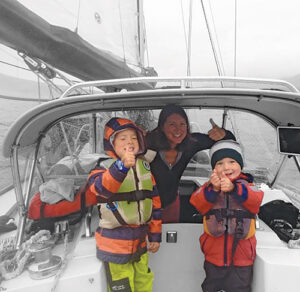
I don’t know who needs to hear this, but even in the summer, it rains… a lot. We found this out on our first summer of cruising in Southeast Alaska, when it rained for what seemed like days on end. Fortunately, we were ready for it—and most sailors from the PNW will be too. That said, it’s worth mentioning that, unless you’re heading straight for the tropics, having a quality set of foul weather gear and boots is imperative. Whether going ashore for beach-combing or hiking, or heading out for a dinghy or kayak exploration, you’ll want to be able to discover things beyond the boat, no matter the weather. If you don’t have the gear, you’ll be wet and miserable. We invested in two sets of gear for our crew, which was one of the best things we did for cruising the Inside Passage. While wearing one set, the other set could be drying; that way we weren’t constantly getting in and out of damp foulies.
Along with proper clothing, pack a positive attitude. No matter where you are, you can’t change the weather, you just have to adapt to it. And if you’re into meeting other cruisers along the way and all you do is complain about the weather, you won’t make fast friends—listening to other sailors incessantly complain about the weather isn’t fun. Just take it as it comes and enjoy where you are!
Don’t Bring… a Schedule
If there is one piece of advice that I can’t stress enough, it’s to not cruise on too rigid of a schedule. Sure, you’ll have an overarching plan of where and when you’ll be in certain areas, but within that plan we’ve found it best to have numerous options. And there have even been times when we’ve completely changed our itinerary on a whim based on weather or if there was a particular destination that worked or didn’t.
I’ll never forget meeting a salty, 70-something-year-old commercial fisherman on the docks in Sitka, Alaska, who was intrigued by our family’s journey and stopped to chat. He asked me where we were going next, and when I said I wasn’t quite sure and that we didn’t really have a hard and fast timeline, he answered. “Good. The most dangerous thing people like you [cruisers] bring to Alaska is a schedule—glad to hear you’re not on one.” He then told us about some of his favorite local anchorages and we ended up visiting several of them, which we would have otherwise missed.
Oftentimes, these experiences of spontaneity—of meeting someone or finding an unexpectedly great spot—are what create the best memories. In many ways, this is what the cruising life is all about.
You have our best wishes on your upcoming extended cruising adventure! Plan as much as you feel is necessary for your boat and crew. Then, when the time comes, cut those dock lines and get out here—a big world awaits.
Andy Cross is the editor of 48° North. After years cruising the Pacific Northwest and Alaska with his family aboard their Grand Soleil 39, Yahtzee, they sailed south and are currently in the Caribbean Sea. You can follow their adventures at SailingYahtzee.com.
Andy Cross
Andy Cross is the editor of 48° North. After years cruising the Pacific Northwest and Alaska with his family aboard their Grand Soleil 39, Yahtzee, they sailed south and are currently in the Caribbean Sea. You can follow their adventures at SailingYahtzee.com.


